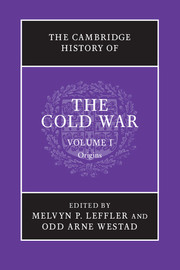Book contents
- Frontmatter
- 1 The Cold War and the international history of the twentieth century
- 2 Ideology and the origins of the Cold War, 1917–1962
- 3 The world economy and the Cold War in the middle of the twentieth century
- 4 The emergence of an American grand strategy, 1945–1952
- 5 The Soviet Union and the world, 1944–1953
- 6 Britain and the Cold War, 1945–1955
- 7 The division of Germany, 1945–1949
- 8 The Marshall Plan and the creation of the West
- 9 The Sovietization of Eastern Europe, 1944–1953
- 10 The Cold War in the Balkans, 1945–1956
- 11 The birth of the People’s Republic of China and the road to the Korean War
- 12 Japan, the United States, and the Cold War, 1945–1960
- 13 The Korean War
- 14 US national security policy from Eisenhower to Kennedy
- 15 Soviet foreign policy, 1953–1962
- 16 East Central Europe, 1953–1956
- 17 The Sino-Soviet alliance and the Cold War in Asia, 1954–1962
- 18 Nuclear weapons and the escalation of the Cold War, 1945–1962
- 19 Culture and the Cold War in Europe
- 20 Cold War mobilization and domestic politics: the United States
- 21 Cold War mobilisation and domestic politics: the Soviet Union
- 22 Decolonization, the global South, and the Cold War, 1919–1962
- 23 Oil, resources, and the Cold War, 1945–1962
- Bibliographical essay
- Index
- References
9 - The Sovietization of Eastern Europe, 1944–1953
Published online by Cambridge University Press: 28 September 2010
- Frontmatter
- 1 The Cold War and the international history of the twentieth century
- 2 Ideology and the origins of the Cold War, 1917–1962
- 3 The world economy and the Cold War in the middle of the twentieth century
- 4 The emergence of an American grand strategy, 1945–1952
- 5 The Soviet Union and the world, 1944–1953
- 6 Britain and the Cold War, 1945–1955
- 7 The division of Germany, 1945–1949
- 8 The Marshall Plan and the creation of the West
- 9 The Sovietization of Eastern Europe, 1944–1953
- 10 The Cold War in the Balkans, 1945–1956
- 11 The birth of the People’s Republic of China and the road to the Korean War
- 12 Japan, the United States, and the Cold War, 1945–1960
- 13 The Korean War
- 14 US national security policy from Eisenhower to Kennedy
- 15 Soviet foreign policy, 1953–1962
- 16 East Central Europe, 1953–1956
- 17 The Sino-Soviet alliance and the Cold War in Asia, 1954–1962
- 18 Nuclear weapons and the escalation of the Cold War, 1945–1962
- 19 Culture and the Cold War in Europe
- 20 Cold War mobilization and domestic politics: the United States
- 21 Cold War mobilisation and domestic politics: the Soviet Union
- 22 Decolonization, the global South, and the Cold War, 1919–1962
- 23 Oil, resources, and the Cold War, 1945–1962
- Bibliographical essay
- Index
- References
Summary
The great Soviet victories at Stalingrad (January 1943) and Kursk (July 1943) reversed the tide of the war against the Nazis and made it likely that Soviet armies would occupy vast stretches of territory in Europe. Allied conferences at Teheran in November 1944 and Yalta in February 1945, and the notorious “percentages agreement” between Iosif Stalin and Winston Churchill in October 1944, confirmed that Eastern Europe, initially at least, would lie within the sphere of influence of the Soviet Union. Communists in the region also assumed that their countries would fall under Soviet sway in one form or another. Milovan Djilas famously recorded Stalin’s assertion during a wartime conversation: “This war is not as in the past: whoever occupies a territory also imposes on it his own social system. Everyone imposes his own system as far as his army can reach. It cannot be otherwise.” Georgi Dimitrov, head of the Soviet Central Committee’s Department of International Information, noted in late January 1945 that Stalin expected a war with the capitalist world within two decades of the Nazi defeat, and therefore it would be necessary to maintain a strong alliance among the Slavic countries of Eastern Europe to counter that aggression.
Yet there is very little evidence that Stalin had firm notions in 1944–45 about developing some sort of Communist bloc in Eastern Europe after the war. Instead, he probably shared many of the suppositions of two of the major policy-planning documents to emerge from the Ministry of Foreign Affairs during World War II, Maxim Litvinov’s “Memorandum” of January 11, 1945, and Ivan Maisky’s “Note” of January 10, 1944. The Litvinov document was prepared in association with the Yalta Conference and explored the possibility of establishing an agreement about three spheres of influence on the continent. Linked to the Soviet Union would be a zone in the east and north, including Finland, Sweden, Poland, Hungary, Czechoslovakia, Romania, Yugoslavia, Bulgaria, and Turkey.
- Type
- Chapter
- Information
- The Cambridge History of the Cold War , pp. 175 - 197Publisher: Cambridge University PressPrint publication year: 2010
References
- 5
- Cited by

